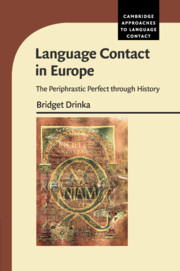Book contents
- Frontmatter
- Contents
- Series Editor's Foreword
- Acknowledgments
- Abbreviations, Based on the Leipzig Glossing Rules
- 1 Language Contact in Europe: The Periphrastic Perfect through History
- 2 Languages in Contact, Areal Linguistics, and the Perfect
- 3 The Perfect as a Category
- 4 Sources of the Perfect in Indo- European
- 5 The Periphrastic Perfect in Greek
- 6 The Periphrastic Perfect in Latin
- 7 The Charlemagne Sprachbund and the Periphrastic Perfects
- 8 The Core and Peripheral Features of the Romance Languages
- 9 The Early Development of the Perfect in the Germanic Languages
- 10 The Semantic Shift of Anterior to Preterite
- 11 The Balkan Perfects: Grammaticalization and Contact
- 12 Byzantium, Orthodoxy, and Old Church Slavonic
- 13 The l- perfect in North Slavic
- 14 Updating the Notion of Sprachbund: New Resultatives and the Circum- Baltic “Stratifi ed Convergence Zone”
- 15 The have Resultative in North Slavic and Baltic
- 16 Conclusions
- Notes
- Bibliography
- Index
15 - The have Resultative in North Slavic and Baltic
Published online by Cambridge University Press: 23 February 2017
- Frontmatter
- Contents
- Series Editor's Foreword
- Acknowledgments
- Abbreviations, Based on the Leipzig Glossing Rules
- 1 Language Contact in Europe: The Periphrastic Perfect through History
- 2 Languages in Contact, Areal Linguistics, and the Perfect
- 3 The Perfect as a Category
- 4 Sources of the Perfect in Indo- European
- 5 The Periphrastic Perfect in Greek
- 6 The Periphrastic Perfect in Latin
- 7 The Charlemagne Sprachbund and the Periphrastic Perfects
- 8 The Core and Peripheral Features of the Romance Languages
- 9 The Early Development of the Perfect in the Germanic Languages
- 10 The Semantic Shift of Anterior to Preterite
- 11 The Balkan Perfects: Grammaticalization and Contact
- 12 Byzantium, Orthodoxy, and Old Church Slavonic
- 13 The l- perfect in North Slavic
- 14 Updating the Notion of Sprachbund: New Resultatives and the Circum- Baltic “Stratifi ed Convergence Zone”
- 15 The have Resultative in North Slavic and Baltic
- 16 Conclusions
- Notes
- Bibliography
- Index
Summary
In a recent article on language contact, Victor Friedman (2012: 411) observes that, while the lexeme ‘have’ exists across the Slavic languages, possessive constructions used in resultative structures are limited to three geographical areas, all somewhat peripheral, and all adopting the structure through the operation of calquing:
• in the Balkan Slavic languages (Bulgarian, Macedonian, and the Torlak dialects of SE Serbia and Southern Kosovo) in contact with the Balkan Romance languages (Romanian, Aromanian, and Meglenoramanian), Albanian, and Greek;
• in N. Russian in contact with Finnic; and
• in Czech and Polish, in contact with German.
The role of contact in the development of the possessive perfects of the Balkans and of N. Russian has been discussed in some detail; in this chapter, we turn our attention to the development of HAVE perfects in Czech, Polish, and the other W. Slavic languages, in western Ukrainian, and in Lithuanian. What we will discover as we briefly examine each of these varieties in turn is that the W. Slavic languages, especially the vernaculars of Czech and Polish, were influenced directly by Western Europe, and developed resultatives modeled on the perfects of German, while Kashubian and the Baltic Sea Slavic varieties, such as Slovincian and Polabian, were influenced even more thoroughly by German, to the extent that the HAVE and BE constructions may be considered perfects. Lithuanian, on the other hand, presents a unique profile that requires further examination.
HAVE Resultatives in the West Slavic Languages
We turn now to the HAVE + -n/t- construction, identified by Clancy (2010: 160) as the “New Slavic Perfect.”
Czech
As noted previously, Czech has had a HAVE resultative from the beginning of its written tradition.
Centuries-long contact with German fostered its growth in the vernacular language (Dickey 2013: 115 fn), though it came to be suppressed in the standard language (Thomas 2003). As in other W. Slavic languages, the HAVE resultative in Czech was first formed with an objective complement and a PPP agreeing in gender, number, and case, but its later loss of agreement in the participle has led some scholars, such as Dickey (2013), to reclassify Czech's resultative structure as a perfect.
- Type
- Chapter
- Information
- Language Contact in EuropeThe Periphrastic Perfect through History, pp. 377 - 394Publisher: Cambridge University PressPrint publication year: 2017



